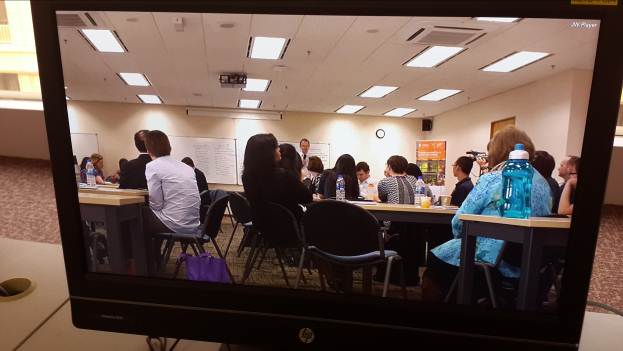
March 21, 2014, by Graham Kendall
U21 KWBN Global Citizenship Workshop Breaks New Ground With Live Streaming of UNMC Events from Semenyih and KLTC venues
This post was contributed by Sean Matthews and Yeong Woon Chin
There was a significant technological ‘first’ for UNMC during the recent U21 KWBN Global Citizenship Workshop, 13-14 March. We used the event to explore our live streaming capabilities, and achieved a successful and well-received feed for the session (the link has been taken down at the time of writing, but our picture is the proof that it did happen – captured during day two at KLTC).
A more detailed technical and ‘how to’ SOP will be developed in the coming weeks, but key personnel to thank – and do contact them if you’re interested in the facility – are Pizli Mat Wazip, Alex Wong Pak Kui, Siti Nur Fazlin, Vivi Lim and Lotus Ong. Not forgetting, our student ambassador from the Nottingham Malaysia Broadcast channel – Dexter Yin. Obviously, feel free to drop us a line, too.
It was great fun, if a little disconcerting, watching both the live streaming and the real event at the same time, while working how best to ensure that the streaming captured the gist of the workshop. Obviously, static keynote type presentations work best – our day one keynote was viewed as far away as Bangsar! – but sufficient attention to logistics and moderation can also make more discursive environments transmissible. Because we were really just testing the technology, we didn’t adapt the form and delivery, either simply in terms of the arrangement of the space or placement of the camera, or formally in terms of making the streaming audience a consideration for the moderator and participants – those would be things to bear in mind in a heavily promoted stream. Certainly, live streaming capability has the potential radically to extend the audience and reach of all our activities, and is something we hope that further events can exploit.
What to do if you want to live stream
Know your live stream venues and programme timings thoroughly.
- Ensure that you have a good internet connection throughout.
- Identify the live stream software (JW player) and upload the link onto the webpage that has the most visits to encourage more viewership and traffic to the page.
- Pretest the live streaming feed at all venues (as it needs to run smoothly without buffering when played ‘live’).
- Identify a good broadcast laptop and camera. Do not use the laptop for anything else while live streaming. Having a tripod would be great for capturing of live streaming at the best angles, instead of having it flat throughout.
- Engage in a good technical team to be on ground at all times. The technical personnel must not be multi-tasking on other activities during the event (that doesn’t mean that they have to be static in a full day event. They need to have the bird’s eye view of the programme running order too).
Most importantly, never panic! Regardless of whether we captured the wrong shots – people spilling coffee and crumbs during coffee break session, poor sound (reviewed post event) in an otherwise perfect event venue, and even having a dark figure suddenly blocking your streaming view half way for a few seconds, you have to accept that such imperfections are part of the ‘live’ experience. Think ‘fly on the wall’ rather than ‘cinema’.
With simple to use technology and excellent technical support, live streaming allowed us to broadcast live to the web and enabled us to engage with the wider audience during the event – a nice touch, given our theme of ‘Global Citizenship’, and the fact that we were collaborating across the U21 network. It was a first for UNMC: as novices in using this technology we do hope to continue doing so during future events, and it’s clear that this innovation has the potential to make a very powerful difference to the reach of many UNMC events.
21 March 2014
No comments yet, fill out a comment to be the first

Leave a Reply